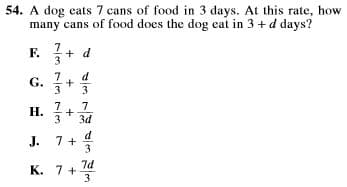How to Think Like the ACT® Math: Functions Without Equations
Read time: 5 minutes Last updated: September 23rd, 2024
Understanding Functions Without Equations
Functions without explicit equations show up at least once or twice on every ACT Math® section. Explicit equations mean these aren't functions where we find slope using slope-intercept or distance using the distance formula.
Instead, these problems have an equation that can be used to solve them, just not in the formula abstract sense like . We have to figure out what the formula would be to solve the question.
Consider This Example
Question:
An apartment building charges $785 a month, plus $90 per person living there. Which of the following equations would represent the cost of living in the apartment for months for people?
Click for the Answer
Correct Answer: B.
Explanation:
The correct equation is because:
- represents the base rent for months
- represents the additional charge for people
Look at the answer choices above. They all contain different expressions. We could prove any of them right or wrong by making up random variables to represent and , say and . Then only one answer choice would be correct.
Even if you don't actually check the equation using Plugging in Numbers, it's still a good technique to keep in mind. Understanding the logic behind why that technique works can help you understand how to do these questions more easily.
More Examples
Example 1:
Consider a scenario where a car rental company charges a base fee of $50 per day and an additional $0.25 per mile driven. Which of the following equations would represent the total cost for renting the car for days and driving miles?
Click for the Answer
Correct Answer: A.
Explanation:
The correct equation is because:
- represents the base fee for days
- represents the additional charge for miles driven
Example 2:
A gym membership costs $30 per month and an additional $10 per class attended. Which of the following equations would represent the total cost for a membership of months and attending classes?
Click for the Answer
Correct Answer: A.
Explanation:
The correct equation is because:
- represents the monthly membership fee for months
- represents the additional charge for classes attended
Advanced Study
These questions can get trickier when they involve more abstract math concepts.

We can actually solve this problem quite easily. This is commonly listed as one of the hardest questions on the ACT® Math. But we can make it very easy. That's the Alexander Charles Tutoring way.
Using the plugging in numbers method from above, we can reason that if we solve this question for a random number , then only one answer choice should return the correct answer. So if a dog can eat 7 cans of dog food in 3 days, how many cans of dog food can it eat in days?
Well, I already know that the dog can eat 7 cans in 3 days. So let's say that days. That makes days = 6 days. The question isn't asking how many days. It wants to know how many cans in days. So if it's 7 cans in 3 days, it should be 14 cans in 6 days. Just double it.
Now, we have to use our calculator to check all of the answer choices. I am suggesting you check all of the answer choices here because this is a more advanced example, per our difficulty. Let's solve.
Advanced Example:
If a dog eats 7 cans of food in 3 days, which of the following expressions represents the number of cans the dog will eat in days?
Click for the Answer
Correct Answer: E.
Explanation:
Let's break down the correct answer:
- 7 represents the number of cans eaten in the first 3 days
- represents the number of cans eaten in the additional days
How is This Going to Show Up on the ACT®?
Functions with no equations will show up in a number of ways. Sometimes, you will be given an equation or expressions in the answer choices. Sometimes you will be given variables and real numbers in the question and real numbers in the answer choices as well. In other cases, the important part is to understand the relationship between or among the numbers in the problem.
The way we understand these relationships is by looking at how they affect one another. If we can reason about the effect one has on another, then we can use the given values to determine the one right solution – whether that's creating an equation, solving an equation, or a little bit of both.
